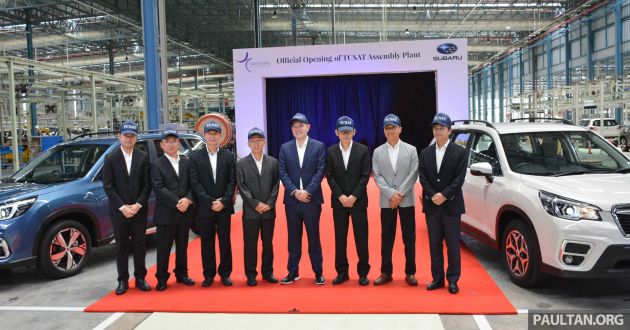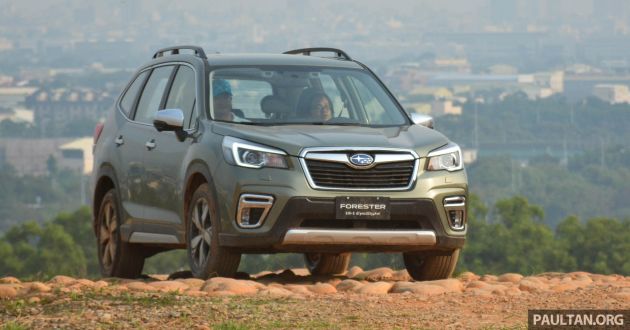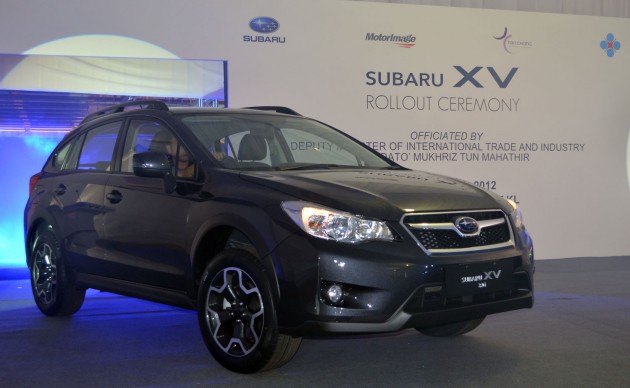During a group interview following the launch of Tan Chong Subaru Automotive (Thailand), or TCSAT, a question was posed to Glenn Tan, managing director of Tan Chong International (TCIL), seeking clarification on why such a facility was not built in Malaysia.
The TCSAT facility was built with an initial investment of five million baht, with TC Manufacturing and Assembly Thailand (TCMA TH), a subsidiary of Singapore-based, Hong Kong-listed TCIL owning a 74.9% share, while Subaru Corporation holds the remaining 25.1%.
According to Tan, production capacity is one of the main challenges being faced. Assembly of Subaru vehicles already exists in Malaysia as part of a contract with Tan Chong Motor Assemblies (TCMA) in Segambut, with the second-generation XV and fourth-generation Forester currently being made at the plant for both Malaysia and Thailand markets.
However, there is a limit in terms of production capacity allocated to these vehicles, which is said to be around 600-650 units per month. As a result of this limitation, deciding how many XVs and Foresters to be produced had an effect on the delivery schedule to customers.


The Segambut facility isn’t just dedicated to producing Subaru vehicles, but also models from other brands like the Mitsubishi ASX and Renault Captur. Tan noted that there was a special understanding with Nissan that allowed for Subaru vehicles to be assembled there in Segambut in the first place.
Tan also stated that building a new plant in Malaysia would destabilise the existing partnership with TCMA. Therefore, the decision was made to build the new TCSAT plant upon land it already owned in Thailand, which is in a special economic zone. As such, the company enjoys tax exemption on machinery, equipment and tools. Additionally, selling the Thailand-made cars in the Kingdom is no affected by duties as well.
With the TCSAT plant assembling the fifth-generation Forester initially, this will ease the demands on the Segambut plant, which can now focus on XV production, while slowly phasing out production of the fourth-gen Forester. As the fifth-gen model will come to Malaysia from Thailand, there’s no need to continue model splitting when it comes to production in Segambut.
Will this arrangement change in the near future? Not for now, at least for this generation of the XV, according to Tan. “The XV has another four years to go so I’ve not decided what we’re going to do with the XV, whether to move production to Thailand or not,” said Tan.
He noted that the TCSAT plant was designed to handle four models, with a production capacity of 100,000 units annually when operating on two shifts, or half of that on just one shift. Given the fact that the XV was launched just last year, it’s unlikely that the second model assembled at TCSAT will be the XV until (at least) the next generation of the model arrives.
“So, if we do assemble another model here (TCSAT) first before the XV, I need to see if the total production number reaches the capacity of one shift. I need to consider whether or not moving the XV makes it viable to move to two shifts,” Tan explained.
“At the one-shift level, it would be more viable to continue XV production in Malaysia. We’ll have to see because the (next-generation XV) isn’t designed yet, so I don’t know how complex it is, so there are many factors at this juncture.”
“I think based on how I look at it, I’m more likely to keep the XV in Malaysia simply because I find it very difficult to move from one shift to two shifts with an additional bump of 5,000 units. So, moving from a borderline 50,000 units to 55,000 units, and then moving to two shifts, it doesn’t make sense. You may as well jump to 70,000 or 80,000 units but I don’t have that kind of volume,” he added.
“So, Segambut gives us a good path to continue this kind of 600-700 volume type production for Malaysia and Thailand. The other thing is the XV at the next generation will introduce a LHD also, and when we do, should Segambut be the one doing it? They will be totally maxed out.” Tan noted, adding the LHD units will be destined for export markets like Vietnam and Cambodia.
“These two countries, we didn’t do it in the first place (for the current-generation XV) because at the time, they were not part of AFTA (ASEAN Free Trade Area). They only have zero import duty for cars from January last year, but at that time, when we were planning (production), I cannot guarantee when they going to start.”
“So, the next generation (XV) will definitely have LHD. Should the volume be enough for just Segembaut , then we will keep (producing) it in Segambut as RHD and LHD, and that will probably max out the capability, and majority of (the cars) will be exported,” he noted.
Research Subaru Cars at
Related Cars for Sale on
Source: Read Full Article

















